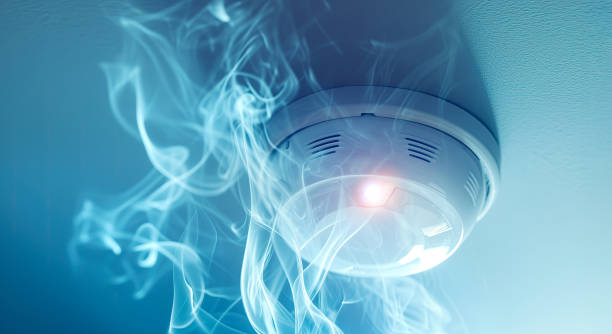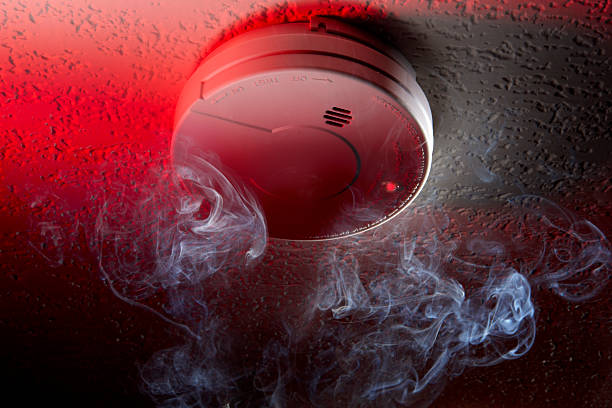In today’s world, where safety is a top priority, understanding smoke detection technologies is essential. Smoke detectors serve as one of the most important devices in preventing fire-related injuries and fatalities. They provide early warnings that can be the difference between life and death, alerting us to the dangers of a fire before it becomes uncontrollable.
According to recent statistics:
Nearly 60% of fire-related deaths occur in homes without working smoke alarms.
Homes with functional smoke detectors report 50% fewer fire-related deaths.
Early detection can increase survival rates by up to 85%.
Understanding the different types of smoke detection technologies and their functions is key to ensuring optimal protection in your home or workplace. The two primary types of smoke detection technologies are Ionisation Smoke Detectors and Photoelectric Smoke Detectors.
These technologies differ in how they detect smoke, and each has its advantages depending on the type of fire it is designed to detect. Let’s take a closer look at these two smoke detection technologies and their differences.
Ionisation Smoke Detectors
Ionisation smoke detection technologies use a small amount of radioactive material (typically americium-241) to ionize the air inside a sensing chamber. This technology operates by creating an electric current between two charged plates within the detector. The presence of smoke particles disrupts this current, triggering the alarm.
How Ionisation Smoke Detectors Work
A small current flows between two electrodes inside a chamber.
As smoke particles enter the chamber, they disrupt this electrical flow.
The disruption causes the alarm to go off, alerting people to a potential fire.
These detectors are particularly sensitive to fast-flaming fires, which involve small, fast-moving flames that produce less visible smoke. As such, Ionisation smoke detectors are ideal for situations where flaming fires might develop quickly, such as in kitchens or areas with easily ignitable materials.
Advantages of Ionisation Smoke Detectors
Quick response to flaming fires: They detect flaming fires faster, usually in 30-50 seconds.
Cost-effective: These detectors are generally less expensive than Photoelectric detectors.
Compact size: Ionisation detectors are small, making them easy to install in various spaces.
Limitations of Ionisation Smoke Detectors
Higher false alarm rates: Due to their sensitivity, Ionisation detectors are more likely to trigger false alarms from things like steam or cooking fumes.
Not as effective for smouldering fires: These detectors take longer to detect smouldering or slow-burning fires, which can be dangerous in certain situations.
Photoelectric Smoke Detectors
Photoelectric smoke detectors use a light-sensing technology to detect the presence of smoke. These detectors have a light source (usually an LED) positioned away from a light sensor. When smoke enters the sensing chamber, it scatters the light, which then hits the sensor. When enough light is detected, the alarm is triggered.
How Photoelectric Smoke Detectors Work
A light source (LED) emits a beam away from the sensor.
When smoke particles scatter the light, some of it hits the sensor.
When enough light reaches the sensor, the alarm is triggered.
Photoelectric smoke detection technologies are particularly effective at detecting smouldering fires, which typically produce a lot of visible smoke but burn slowly. These detectors are ideal for spaces where slow-burning fires, like those caused by electrical malfunctions or overheating materials, are a risk.
Advantages of Photoelectric Smoke Detectors
Fewer false alarms: These detectors are less likely to trigger false alarms compared to Ionisation detectors.
Faster response to smouldering fires: Photoelectric detectors are ideal for detecting slow-burning or smouldering fires, which can spread for long periods without creating visible flames.
Lower maintenance: Generally, Photoelectric detectors need fewer maintenance checks and have a lower tendency to trigger false alarms due to dust or steam.
Limitations of Photoelectric Smoke Detectors
Slower response to flaming fires: They are not as fast at detecting fast-flaming fires as Ionisation detectors. Their response time for flaming fires can be between 120-180 seconds.
Comparison of Ionisation and Photoelectric Smoke Detectors
Here’s a detailed comparison of Ionisation vs. Photoelectric Smoke Detectors to help you understand their strengths and weaknesses in different scenarios.
Feature Ionisation Photoelectri
Feature Ionisation Photoelectric
Response Time (Flaming Fires) 30-50 seconds 120-180 seconds
Response Time (Smouldering Fires) 15-50 minutes 20-50 seconds
False Alarm Rate Higher Lower Cost Cheaper More Expensive
Battery Life 1-2 years 1-2 years
Best For Fast-moving, small flames Slow, smouldering fires
Both Ionisation and Photoelectric smoke detectors play important roles in fire safety, but the best option depends on the fire risks present in your environment. Ionisation detectors work well in areas like kitchens or where open flames are common, while Photoelectric detectors are better for areas where smouldering fires are more likely to occur.
Plug-In Smoke Detectors: Are They a Good Option?
Another option for smoke detection is plug-in smoke detectors, which plug directly into standard electrical outlets. These detectors offer several advantages but also come with certain limitations.
Advantages of Plug-In Smoke Detectors
Continuous power supply: No need to replace batteries regularly.
Easy installation: These detectors are easier to install compared to hard-wired models.
Backup batteries: Many plug-in detectors include backup batteries in case of power failure.
Built-in features: Some plug-in detectors come with added features such as night lights.
Limitations of Plug-In Smoke Detectors
Limited placement options: Plug-in detectors must be placed near an electrical outlet, limiting their placement locations.
May be blocked by furniture: Furniture and other obstructions can block the sensors’ ability to detect smoke.
Not ideal for ceiling installation: Plug-in detectors are typically not suitable for installation on the ceiling.
Do Fire Alarms Detect Carbon Monoxide?
A common question is whether fire alarms detect carbon monoxide (CO), the odorless and colorless gas that can be deadly in high concentrations. Fire alarms and carbon monoxide detectors serve different functions, but some modern alarms combine both smoke and CO detection into a single unit.
Carbon Monoxide and Fire Alarms
Fire alarms detect smoke particles: These alarms are designed to detect smoke from a fire.
CO detectors detect carbon monoxide: These devices detect dangerous levels of CO gas in the air.
Combined units: Many newer smoke alarms combine both functions, offering protection against both smoke and carbon monoxide in one device.
Types of Fire Alarms with CO Detection
Modern smoke alarms with CO detection offer several benefits over traditional separate units. These dual-function devices are designed to keep you safe from both fires and carbon monoxide exposure, ensuring comprehensive protection in the home.
Feature Single Function Combined Unit
Installation Cost Higher (two units) Lower (one unit)
Space Required More Less
Maintenance Two systems One system
Battery Life Varies Usually 10 years
Hard-Wired Fire Alarms and Their Benefits
Hard-wired fire alarms connect directly to your home’s electrical system and are considered the gold standard in fire safety.
Advantages of Hard-Wired Fire Alarms
Reliable power: They rely on your home’s power grid, so you don’t have to worry about battery replacements.
Constant protection: Provides peace of mind knowing the system will operate as long as your home is connected to electricity.
Interconnected systems: Many hard-wired systems can be connected to one another, meaning if one alarm sounds, they all do.
Professional monitoring: Some systems offer 24/7 monitoring services for added protection.
Hard-Wired vs. Battery-Operated Alarms
System Type Battery-Operated Systems Hard-Wired Systems
Installation Cost Low High
Maintenance Regular battery changes Minimal maintenance
Reliability Dependent on battery life Constant power supply
Hard-wired fire alarms are more expensive to install initially but offer long-term benefits such as reliability, lower maintenance, and potential reductions in insurance premiums.
Interconnected Smoke Detectors: Enhancing Safety
Interconnected smoke detectors are the latest development in fire safety technology. These systems are networked together, ensuring that when one alarm detects smoke, all alarms in the system sound simultaneously.
Benefits of Interconnected Smoke Detectors
Whole-house protection: If one detector goes off, you’ll hear alarms throughout the property.
Faster evacuation: With alarms throughout the house, everyone is alerted quickly, improving evacuation times.
Remote monitoring: Some systems can integrate with smart home devices, allowing you to receive alerts on your smartphone.
Conclusion:
Smoke detection technologies choosing the Right Smoke Detector for Your Home
Choosing the right smoke detection technology is essential for protecting your home or business. Ionisation and Photoelectric detectors each have their strengths and weaknesses


